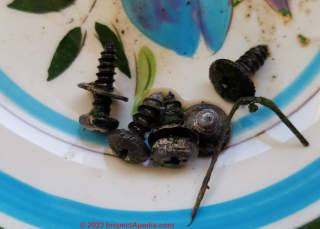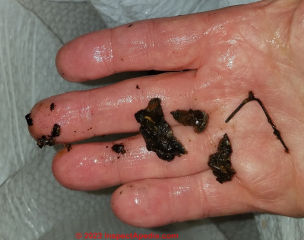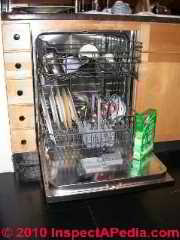 Dishwasher Drain Failure Diagnosis
Dishwasher Drain Failure Diagnosis
Causes & repair for a dishwasher that stops draining
- POST a QUESTION or COMMENT about : diagnosis & repair help for dishwashers
This article lists the causes of dishwasher drain failiures: why won't the dishwasher pump out its used or dirty water.
We list several quick inspection points and tips that can fix the problem, followed by a detailed description of a dishwasher pump and impeller failure that, along with rust, led to a decision to replace the appliance.
We include a description of bailing out a flooded dishwasher, disassembling its impeller and pump assembly to clean it, and how we decided that the dishwasher needed replacement.
InspectAPedia tolerates no conflicts of interest. We have no relationship with advertisers, products, or services discussed at this website.
- Daniel Friedman, Publisher/Editor/Author - See WHO ARE WE?
Why the Dishwasher Won't Drain
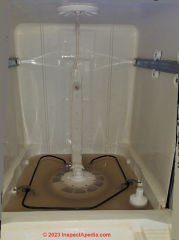 6 Reasons that a Dishwasher Stops Draining
6 Reasons that a Dishwasher Stops Draining
If a dishwasher stops draining its wash-water there are several common causes:
[Click to enlarge any image]
- The dishwasher drain hose itself may be
clogged
- this is an easy repair but you may need to pull out the dishwasher to inspect the entire drain line. - The plumbing drain
to which the dishwasher is connected may itself be blocked
- in this case you should notice that the sink or garbage disposer to which the dishwasher's drain is connected is also draining slowly or not draining at all. If this is the trouble,
See CLOGGED DRAIN DIAGNOSIS & REPAIR - The dishwasher's bottom drain strainer may be clogged
- try bailing out the dishwasher and cleaning the straine - The dishwasher's timer may be faulty
- try manually advancing the dishwasher timer control if your dishwasher permits that. Some modern dishwashers don't use a rotating timer control but may have buttons that can advance the cycle to RINSE. - The dishwasher's impeller assembly
- the pump component that pushes dishwasher drain water through and out its drain connection - may be broken or clogged with debris.
We describe this problem in detail below on this page. - The pump motor itself may be defective
- if the dishwasher is fairly new and if its bottom is not badly rusted, the pump motor can be replaced by an appliance repair person or by a homeowner who is capable of minor but safe electrical wiring and can use hand tools to dis-assemble and re-assemble the dishwasher parts.
It's remarkable how long a dishwasher may keep working without following the manufacturer's recommendation for cleaning its strainer.
Food and debris collect in the strainer, usually a removable screen in the dishwasher bottom that screens dishwasher drain water before it enters the dishwasher pump.
OPINION: But eventually you're washing your dishes with some pretty nasty water (photo above), even if they look clean at the end of a cycle.
Diagnose & Repair (or replace) a Dishwasher Impeller or Pump Failure
Debris Clogging at the Dishwasher Strainer Leads to Pump Failure & Washing Dishes in Nasty Water
This older Two Harbors Minnesota dishwasher (above) was still in daily use, but on closer inspection we saw that it was not draining - it was simply using the same dirty water to wash each load of dishes (photo below).
As we noted above on this page, often when a dishwasher won't drain it's simply due to a kinked or clogged drain line between the dishwasher and the sink trap to which it's attached.
But not always. An inspection of this dishwasher didn't disclose any problem with the drain line itself.
To diagnose the trouble and to see if we could repair it, first we bailed out the dishwasher bottom to remove the standing water. (Photo above)
Then we dis-assembled the bottom strainer and water inlet to look for and remove debris (below). This dishwasher was not designed for easy strainer cleaning or repair.
If you make note of the model and serial number of your dishwasher (below) you might be able to find the installation and repair manual for it and therein a parts explosion, though for a 15-20 year old appliance that becomes more-difficult.
Here is Whirlpool's parts explosion for this dishwasher, with parts and parts explosions available from Sears Parts Direct.
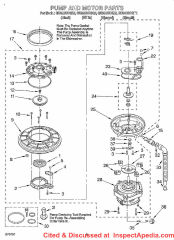
[Click to enlarge any image]
To remove the strainer parts enough to even access the pump impeller required removal of many parts (most not shown here).
Finally, by unscrewing enough parts to remove the strainer cover over the impeller assembly of the dishwasher's water pump (below)
we could remove the dishwasher pump impeller itself for inspection (below).
At Dishwasher Repair we noted that decades of food waste as well as loose screws had clogged, blocked, and finally broken the impeller pump in the dishwasher base. This Whirlpool dishwasher had been in daily use since 2009. We bailed out water, using a rag and sponge to get up the last bit, then
removed this nasty glop found inside of the pump assembly.
But the glop in my hand wasn't the culprit. Something worse was amiss - inside of the pump and impeller assembly below. To proceed to disassemble the dishwasher pump it was helpful to look at a parts explosion for this specific model.
We began cleaning the impeller assembly, there disclosing that the dishwasher bottom was rusting-through (photo below) - not good news.
Seeing that rust - the tip of the iceberg as more rust will be on the dishwasher's under-side, a normal appliance repair person would stop wasting labor and money and simply call for a complete replacement. We agree with that diagnosis.
In this case, as we were going to replace the dishwasher anyway, and as I wasn't charging for labor, we continued the dis-assembly in order to better understand what had gone wrong with this dishwasher.
We found broken bits of plastic, sheet metal screws and even a bit of wire - more than enough to jam the dishwasher pump and as a result, burn-up the pump motor.
and chunks of rusty metal that were a bad sign (below). It's obvious that these screws and wire would ultimately jam the dishwasher impeller and pump.
Unfortunately the combination of age and rusty dishwasher bottom made this appliance beyond economic repair. We replaced it. \
Steps to replace a dishwasher are given at the Continue Reading link below.
...
Continue reading at DISHWASHER INSTALLATION & REPAIR or select a topic from the closely-related articles below, or see the complete ARTICLE INDEX.
Or see these
Recommended Articles
- APPLIANCE DIAGNOSIS & REPAIR
- DISHWASHER INSTALLATION & REPAIR - step by step illustrated guide to installing a dishwasher, new or replacement.
- DISHWASHERS vs SEPTICS - the impact of dishwasher water volume or dish washing detergent on private septic systems and soakaway beds.
Suggested citation for this web page
DISHWASHER DRAIN CLOG DIAGNOSIS at InspectApedia.com - online encyclopedia of building & environmental inspection, testing, diagnosis, repair, & problem prevention advice.
Or see this
INDEX to RELATED ARTICLES: ARTICLE INDEX to APPLIANCE REPAIR
Or use the SEARCH BOX found below to Ask a Question or Search InspectApedia
Ask a Question or Search InspectApedia
Try the search box just below, or if you prefer, post a question or comment in the Comments box below and we will respond promptly.
Search the InspectApedia website
Note: appearance of your Comment below may be delayed: if your comment contains an image, photograph, web link, or text that looks to the software as if it might be a web link, your posting will appear after it has been approved by a moderator. Apologies for the delay.
Only one image can be added per comment but you can post as many comments, and therefore images, as you like.
You will not receive a notification when a response to your question has been posted.
Please bookmark this page to make it easy for you to check back for our response.
IF above you see "Comment Form is loading comments..." then COMMENT BOX - countable.ca / bawkbox.com IS NOT WORKING.
In any case you are welcome to send an email directly to us at InspectApedia.com at editor@inspectApedia.com
We'll reply to you directly. Please help us help you by noting, in your email, the URL of the InspectApedia page where you wanted to comment.
Citations & References
In addition to any citations in the article above, a full list is available on request.
- In addition to citations & references found in this article, see the research citations given at the end of the related articles found at our suggested
CONTINUE READING or RECOMMENDED ARTICLES.
- Carson, Dunlop & Associates Ltd., 120 Carlton Street Suite 407, Toronto ON M5A 4K2. Tel: (416) 964-9415 1-800-268-7070 Email: info@carsondunlop.com. Alan Carson is a past president of ASHI, the American Society of Home Inspectors.
Thanks to Alan Carson and Bob Dunlop, for permission for InspectAPedia to use text excerpts from The HOME REFERENCE BOOK - the Encyclopedia of Homes and to use illustrations from The ILLUSTRATED HOME .
Carson Dunlop Associates provides extensive home inspection education and report writing material. In gratitude we provide links to tsome Carson Dunlop Associates products and services.


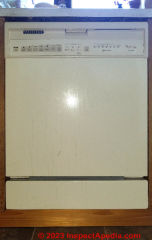
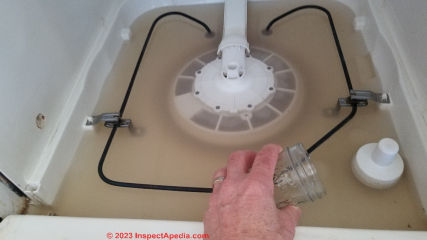



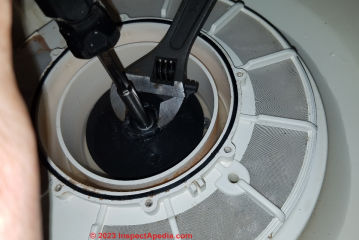
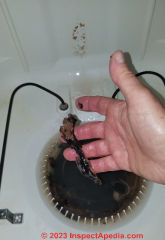

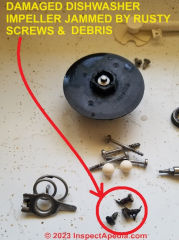 ...
... 